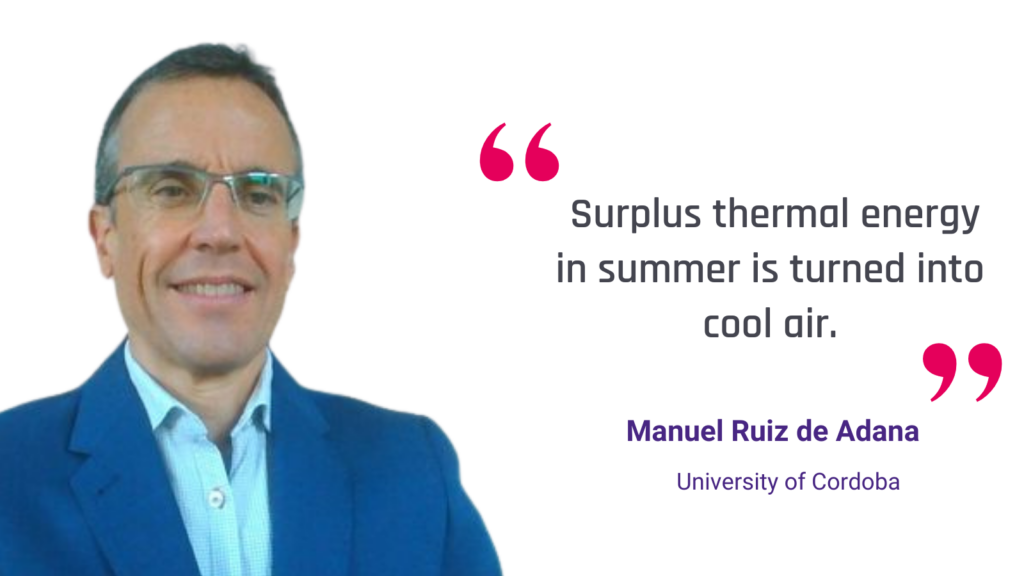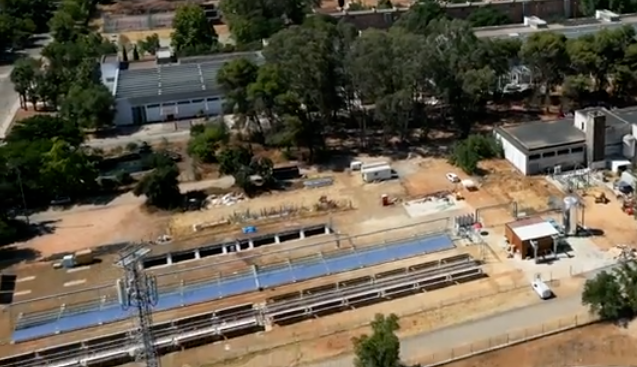
Manuel Ruiz de Adana, a professor of Energy Engineering at the University of Cordoba, is the scientific manager of the W.E.District demosite in Cordoba – a European funded project aimed at demonstrating the economic viability of 100% renewable air conditioning solutions for buildings. The project, implemented at the University of Cordoba’s Rabanales campus, combines various renewable technologies to achieve year-round heating and cooling. In this interview, Professor Ruiz de Adana discusses the project’s challenges, innovations, and potential impact on the future of energy-efficient building systems.
ESCI: This demonstration site for renewable district heating and cooling is quite special . What is the main challenge of the site?
Professor Manuel Ruiz de Adana: What we want to demonstrate with this project is that it is possible to build and operate economically viable installations that provide air conditioning services in winter and summer to a group of buildings in a 100% renewable way. This is the objective of the W.E.District project. In the case of the pilot plant at the University of Cordoba, we combine different renewable technologies to see which combination allows us to guarantee and make more viable the delivery of cold or hot water to air-condition the buildings or a group of buildings.
ESCI: Is this approach of bringing different technologies together the main innovation aspect of the project?
Professor Manuel Ruiz de Adana: Yes, one of the most important challenges of the project is to combine different technologies and operate them to identify which combination provides the best energy and economic efficiency to provide year-round HVAC service (Heating, ventilation, and air conditioning) to the buildings. In the case of the pilot plant at the University of Cordoba, an additional challenge is how to supply the buildings with cooling in a renewable way. This is a challenge that only southern European countries face, and with this pilot plant, we aim to maintain the energy demand of the buildings for cooling and heating in a renewable way all year round.
ESCI: This is the first time that this pilot plant will be installed here in Córdoba. What was your first thought about being part of this innovative project?
Professor Manuel Ruiz de Adana: Yes, it is a very exciting challenge to be part of the W.E. District project. There are many technical, scientific, economic, financial, and administrative challenges. The research team at the University of Cordoba, responsible for developing this project, finds it a great challenge to make this project a reality on campus. We believe it could be a very good opportunity for the University of Cordoba to integrate all these new technological solutions for providing cooling and heating to buildings in a renewable way.
ESCI: When you started the project here in Córdoba with the pilot plant, what was the main goal to achieve by the end of the project?
Professor Manuel Ruiz de Adana: The biggest challenge we set for ourselves when bringing the Wedistrict pilot plant to the University of Cordoba was combining all the technologies, operating them, and obtaining results that can be used to apply similar solutions in other cities, neighborhoods in Spain or southern Europe. This would allow us to gain knowledge and learn which is the most viable solution within the set of renewable solutions that this pilot plant offers.
ESCI: This pilot plant can be used by engineers, students and research colleagues. What was the most challenging part of creating this plant?
Professor Manuel Ruiz de Adana: From a teaching point of view, we are very fortunate to have this pilot plant. We refer to it as a “living laboratory” or “Living Lab.” The challenge in this case is to have a pilot plant prepared so that engineering students at this university, particularly industrial engineering students, can learn and do their practical work in a real installation that provides renewable air conditioning services to nearby buildings such as the Da Vinci building [offices for researchers] or the Monte Cronos facilities [changing rooms of sports stadium].
ESCI: Now that we are close to the end of the project, what could be the outcome or benefit of this pilot plant for stakeholders and others interested in finding these solutions?
Professor Manuel Ruiz de Adana: The benefits of this pilot plant, first of all for the University of Cordoba, include having a leading facility that can attract companies engaged in developing technological solutions in the field of renewable energies to provide air conditioning services to buildings. This could continue into the future with a line of research and technological development of these technologies. At the institutional level, we intend to showcase these technologies to city council managers or local and regional institutions, so they can see a live installation with concrete results and extend this type of solution to other cities and towns in Spain and southern Europe. Furthermore, from a research perspective, much remains to be covered in the development of district networks throughout Europe, especially in providing cooling services to buildings in a renewable way and managing thermal storage processes – both cold and heat – to optimize them from technical and financial points of view.
ESCI: How scalable are these installations – for example for communities or different buildings in neighborhoods?
Professor Manuel Ruiz de Adana: The scalability of the pilot plant is not limited. Here we have specific installed power—1.5 Megawatts of heat and half a Megawatt of cooling. The plant is designed to cover the needs of two buildings on the Rabanales campus, but it can be scaled up to serve more buildings, neighborhoods, or city parts. The goal is to show that it’s viable for a small set of buildings and possibly extend it to the rest of the campus or other areas, depending on the university authorities’ decisions. Similarly, it can be scaled and applied to any neighborhood or city area in Spain or southern Europe.
ESCI: What are the positive and negative aspects of theses solutions from your perspective?
Professor Manuel Ruiz de Adana: From the practical results of this installation, the main barriers we encountered were the licensing and administrative barriers. These should be addressed to develop such facilities to provide air conditioning services to neighborhoods or communities. Technologically, this installation helps deepen the knowledge of the best combination of renewable technologies for different climates and building types. On the positive side, these solutions contribute to decarbonizing buildings, which is a main objective at the European level. They allow for the decarbonization of a group of buildings or an entire city area instead of going house by house or block by block. In this way, accelerating the process associated with the energy consumption of air conditioning systems in buildings is possible.

ESCI: Have you faced any regulatory challenges?
Professor Manuel Ruiz de Adana: The challenges we aim to meet with this installation for local, municipal, or regional authorities include, first of all, raising awareness that these renewable solutions are viable for sets of buildings or cities. We need to decarbonize cities, and this is an example of how it could be done. We also want to convey the need to adapt and develop regulations that allow the integration of these technologies into our cities to make them increasingly carbon-neutral. With this plant, we want to attract managers, inform them about these technological solutions, and discuss the necessary regulatory developments to support the growth of such solutions in today’s cities.
ESCI: What do you see as the future of this development?
Professor Manuel Ruiz de Adana: The target sector for this technology is the building sector, including both residential and non-residential buildings. It could also be applied to the industrial sector where there are air conditioning needs, which many industries have.
ESCI: What are the main key results after these almost five years of the W.E. District project?
Professor Manuel Ruiz de Adana: One of the most important indicators at this plant it that we intend to demonstrate is the reduction in CO2 emissions associated with the energy consumption of air conditioning systems. In this case, we expect a reduction of between 80% to 95% compared to current systems. Another objective is to increase the contribution of renewable primary energy when this project is connected to the campus buildings. There are also economic and environmental indicators that we consider, and by the end of the project, we aim to optimize the operating costs by combining different technologies based on meteorological variables, solar availability, biomass resources, and the costs of these resources.
ESCI: In terms of energy efficiency, how does this system compare to others?
Professor Manuel Ruiz de Adana: The advantage from an efficiency standpoint is that the energy inputs to this plant mostly come from renewable resources. We have the solar rescource in which we have an advantage over other areas in Europe, but also the biomass from strong production in agricultural and forestry sectors. Compared to other conventional systems, this plant is extremely efficient because its energy consumption is minimal, as most of the energy input comes from renewable energy sources.
ESCI: What is the advantage of using thermal energy compared to using electricity for heating or cooling?
Professor Manuel Ruiz de Adana: Today, the expansion of renewable energies, particularly photovoltaics, is very striking. However, the thermal part, which we work on in this plant, is also very important as it directly matches the thermal demands of buildings. Unlike other systems that require converting electricity into thermal energy, our plant produces thermal energy directly, which is what the buildings need. This way, we avoid the conversion step, resulting in higher efficiency. For example, this plant uses solar energy for thermal production and biomass for heat production. It also has absorption equipment that converts hot water into cold water, allowing us to supply buildings with both cold and hot water from renewable sources throughout the year.
ESCI: What is the main specialty of the system?
Professor Manuel Ruiz de Adana: Our research group has been wondering how to convert surplus thermal energy in summer into cool air for air conditioning. This led to the development of a piece of equipment we call RACU (Renewable Air Conditioning Unit).
ESCI: Thank you for this interview!